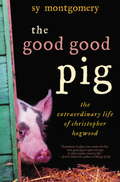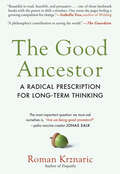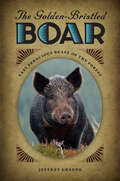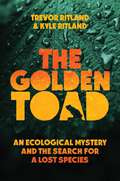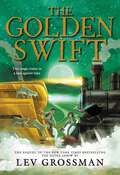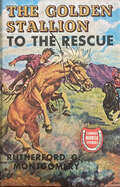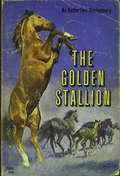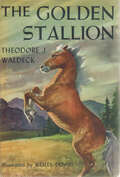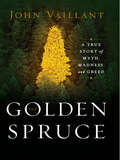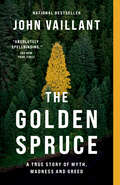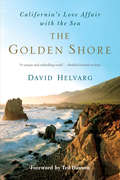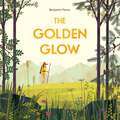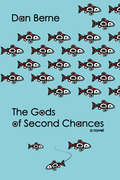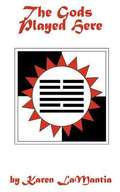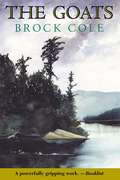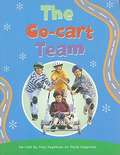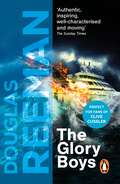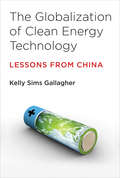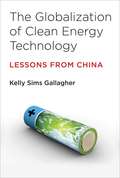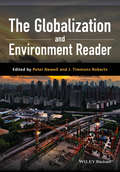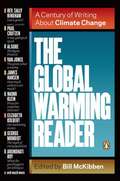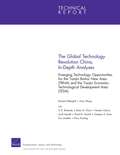- Table View
- List View
The Good Good Pig: The Extraordinary Life of Christopher Hogwood
by Sy Montgomery“Christopher Hogwood came home on my lap in a shoebox. He was a creature who would prove in many ways to be more human than I am.”–from The Good Good PigA naturalist who spent months at a time living on her own among wild creatures in remote jungles, Sy Montgomery had always felt more comfortable with animals than with people. So she gladly opened her heart to a sick piglet who had been crowded away from nourishing meals by his stronger siblings. Yet Sy had no inkling that this piglet, later named Christopher Hogwood, would not only survive but flourish–and she soon found herself engaged with her small-town community in ways she had never dreamed possible. Unexpectedly, Christopher provided this peripatetic traveler with something she had sought all her life: an anchor (eventually weighing 750 pounds) to family and home.The Good Good Pig celebrates Christopher Hogwood in all his glory, from his inauspicious infancy to hog heaven in rural New Hampshire, where his boundless zest for life and his large, loving heart made him absolute monarch over a (mostly) peaceable kingdom. At first, his domain included only Sy’s cosseted hens and her beautiful border collie, Tess. Then the neighbors began fetching Christopher home from his unauthorized jaunts, the little girls next door started giving him warm, soapy baths, and the villagers brought him delicious leftovers. His intelligence and fame increased along with his girth. He was featured in USA Today and on several National Public Radio environmental programs. On election day, some voters even wrote in Christopher’s name on their ballots.But as this enchanting book describes, Christopher Hogwood’s influence extended far beyond celebrity; for he was, as a friend said, a great big Buddha master. Sy reveals what she and others learned from this generous soul who just so happened to be a pig–lessons about self-acceptance, the meaning of family, the value of community, and the pleasures of the sweet green Earth. The Good Good Pig provides proof that with love, almost anything is possible.From the Hardcover edition.
The Good Ancestor: A Radical Prescription For Long-term Thinking
by Roman KrznaricFrom leading philosopher Roman Krznaric, an urgent call to save ourselves and our planet by getting to the root of the current crisis—society’s extreme short-sightedness As heard on NPR’s TED Radio Hour When Jonas Salk developed the polio vaccine, he refused to patent it—forgoing profit so that more lives could be saved. His radical generosity to future generations should inspire us, but leading philosopher Roman Krznaric sees the opposite happening: Our short-term, exploitative mindsets have “colonized the future,” leaving an inexcusable chasm between the haves and have-nots—and mounting existential threats—that have brought our species to the precipice of disaster. Yet Krznaric sees reason to hope. The urgent struggle for intergenerational justice calls for hugely ambitious solutions, from rewiring our growth-at-all-costs economy to giving voters of future generations a voice in our democracies. But at the heart of all these changes is one we can enact within ourselves: We must trade shortsightedness for long-term thinking. In The Good Ancestor, Krznaric reveals six practical ways we can retrain our brains to think of the long view and to shift our allegiance from this generation to all humanity—to save our planet and our future.
The Golden-Bristled Boar: Last Ferocious Beast of the Forest
by Jeffrey GreeneThe wild boar appears to us as something straight out of a myth. But as Jeffrey Greene learned, these creatures are very real, living by night and, despite shrinking habitats and hordes of hunters, thriving on six continents. Greene purchased an eighteenth-century presbytery in a region of ponds and forests in northern Burgundy between the Loire and Seine Rivers of France. He soon discovered he’d moved to one of the most densely populated boar areas in Europe. Following the gift of a side of boar from a neighbor, and a dramatic early-morning encounter with a boar-hunting party and its prey, Greene became fascinated with the animal and immersed himself in the legend and the reality of the wild boar. Although it has no natural enemies, the boar is in constant conflict with humans. Most societies consider it a pest, not only wreaking havoc on crops and livestock, but destroying golf-course greens in search of worms, even creating a hazard for drivers (hogs on the roads cause over 14,000 car accidents a year in France). It has also been the object of highly ritualized hunts, dating back to classical times.The animal’s remarkable appearance--it can grow larger than a person, and the males sport prominent tusks, called "whetters" and "cutters"--has inspired artists for centuries; its depictions range from primitive masks to works of high art such as Pietro Tacca’s Porcellino and paintings by Velázquez and Frans Snyders. The boar also plays a unique role in myth, appearing in the stories of Hercules and Adonis as well as in the folktale Beauty and the Beast.The author’s search for the elusive animal takes him to Sardinia, Corsica, and Tuscany; he even casts an eye to the American South, where he explores the boar’s feral-pig counterparts and descendents. He introduces us to a fascinating cast of experts, from museum curators and scientists to hunters and chefs (who share their recipes) to the inhabitants of chateaux who have lived in the same ancient countryside with generations of boars. They are all part of a journey filled with wonders and discoveries about these majestic animals the poet Robinson Jeffers called "beautiful monsters."
The Golden Toad: An Ecological Mystery and the Search for a Lost Species
by Trevor Ritland Kyle RitlandThe Costa Rican cloud forest, a mysterious amphibian killer, and a vanished species: with support from Leonardo DiCaprio&’s Re:wild campaign, twin documentarians and environmental writers follow their father&’s footsteps into the heart of the modern extinction crisis. As young boys, Trevor and Kyle Ritland were fascinated by the magnificent golden toad of Costa Rica, a brilliant species their biologist father showed them in his projector&’s slide shows. Native to only one wind-battered ridgeline high on the continental divide above the cloud forests of Monteverde, thousands of golden toads would congregate for a few weeks each year in ephemeral pools among the twisted roots to mate, deposit their offspring, and retreat again beneath the earth. But from one year to the next, the toads disappeared without a trace; the last of them vanished more than thirty years ago. Since then, only rumors remain—alleged sightings by local residents, which beg the question: could the golden toad still be alive? In The Golden Toad, Trevor and Kyle set off to investigate an environmental mystery with unexpected revelations, a story that speaks to our own collective and uncertain future. Guided by Costa Rican naturalists—including the last person to have seen the golden toad alive—Trevor searches for survivors while Kyle hunts the killer, and their paths lead them through an imperiled forest, a deadly pandemic, and a changing climate, finally intertwining at the site of the golden toad&’s last emergence deep in Monteverde&’s Bosque Eterno de Los Niños. The toad&’s demise becomes a haunting foretelling of approaching ecological crisis, but with a gold lining on the horizon. The Golden Toad changes the conversation around extinction, climate change, and conservation while exploring environmental grief, resurrection, and hope in a changing world.
The Golden Swift (The Silver Arrow)
by Lev GrossmanIn this thrilling adventure in the New York Times bestselling Silver Arrow series, Kate and Tom must confront the limits of what even magic can do—all while trying to bring balance back to the world. A lot has changed for Kate in a year. She and Tom are now full-fledged conductors of the steam-powered, animal-saving Great Secret Intercontinental Railway. Life is good! Or good-ish, anyway. Her uncle Herbert has gone missing, and the worsening climate means that there are more and more animals that need help all the time. How many times does Kate have to save the world before it stays saved? And her real life isn&’t exactly perfect either. She flunked her audition for the junior high musical and got stuck in the chorus, while her archenemy Jag got a lead. So, out of desperation, Kate breaks the rules and takes the Silver Arrow out on an unsanctioned mission, to find Uncle Herbert and bring back balance to the world. But she quickly discovers she&’s not the only one on the Great Secret Intercontinental Railway. There&’s a mysterious train called the Golden Swift out there too, with an agenda of its own. Is it an ally? A rival? An enemy? A bit of all three? The question will turn Kate&’s world upside down, take her from the Scottish Highlands to the Australian outback to the bottom of the Bering Sea, and lead her straight on a collision course with the mysterious masters of the Great Secret Intercontinental Railway itself. Because when you're a human being fighting to save nature, are you the hero or are you the villain? There are no simple answers.
The Golden Stallion to the Rescue: Golden Stallion #3 (Famous Horse Stories)
by Rutherford MontgomeryWhen Charley Carter’s mother tries to make some much-needed money for the family by inviting boys to spend the summer at the Bar L Ranch, Rodney, a boy with a passion for geology, is the only one who comes. As he learns about working on the ranch, he spends long periods of time alone, and more time visiting Golden Boy, the beautiful once-wild stallion who keeps the ranch’s mares together. But soon Charley discovers Rodney has a plan for his rich father, an oil man, to drill for oil in the wild mountain country, and Rodney arranges to buy Golden Boy and move him East. It looks like the Carters will lose their ranch and everything they value. Worse, Golden Boy is being left to die by Rodney’s horse trainer who believes the horse is a killer. Can Charley save his life and bring him home?
The Golden Stallion
by Rutherford MontgomeryCharlie was determined to have the palomino for his very own. But Golden Boy was a wild stallion who loved his freedom. And he would fight before giving it up. Catching him wouldn’t be easy! An edition especially edited for younger readers of Rutherford Montgomery's Famous Horse Stories novel "The Capture of the Golden Stallion."
The Golden Stallion
by Theodore J. WaldeckThe clear, cold air of the mountain heights, the sense of space and freedom that is to be found in the peaks of the Sierras and their valleys, the thundering beauty and intelligence of wild horses--all this, and more, is to be found in The Golden Stallion, the first book with a North American background to be written by Theodore Waldeck, famous explorer and author of African and South American jungle stories. Young Bob, brought up by his rancher father to know and love horses, lives for the day when he can have one of his very own. Golden Blaze is the name he gives the beautiful wild horse which is captured for him, and their adventures together, with a surprise ending, form this thrilling story of life in the American West, a story which adds to Mr. Waldeck’s firmly established reputation for taking his readers on stimulating adventures.
The Golden Spruce: A True Story of Myth, Madness, and Greed
by John VaillantA tale of obsession so fierce that a man kills the thing he loves most: the only giant golden spruce on earth. When a shattered kayak and camping gear are found on an uninhabited island in the Pacific Northwest, they reignite a mystery surrounding a shocking act of protest. Five months earlier, logger-turned-activist Grant Hadwin had plunged naked into a river in British Columbia's Queen Charlotte Islands, towing a chainsaw. When his night's work was done, a unique Sitka spruce, 165 feet tall and covered with luminous golden needles, teetered on its stump. Two days later it fell. As vividly as John Krakauer puts readers on Everest, John Vaillant takes us into the heart of North America's last great forest.
The Golden Spruce: A True Story of Myth, Madness and Greed
by John VaillantThe Golden Spruce is the story of a glorious natural wonder, the man who destroyed it, and the fascinating, troubling context in which his act took place. A tree with luminous glowing needles, the golden spruce was unique and, biologically speaking, should never have reached maturity; Grant Hadwin, the man who cut it down, was passionate, extraordinarily well-suited to wilderness survival, and to some degree unbalanced. But as John Vaillant shows, the extraordinary tree stood at the intersection of contradictory ways of looking at the world; the conflict between them is one reason it was destroyed. Taking in history, geography, science and spirituality, this book raises some of the most pressing questions facing society today. The golden spruce stood in the Queen Charlotte Islands (Haida Gwaii), an unusually rich ecosystem where the normal lines between species blur. Without romanticizing, Vaillant shows that this understanding is typified by the Haida, the native people who have lived there for millennia, and for whom the golden spruce was an integral part of their history and mythology. But seen a different way, the golden spruce stood in block 6 of Tree Farm License 39. Grant Hadwin had worked as a remote scout for timber companies. But over time Hadwin was pushed into a paradox: the better he was at his job, the more the world he loved was destroyed. On January 20, 1997, with the temperature near zero, Hadwin swam across the Yakoun River with a chainsaw. He tore into the golden spruce, leaving it so unstable that the first wind would push it over. A few weeks later, Hadwin set off in a kayak across the treacherous Hecate Strait to face court charges. He has not been heard from since.Vaillant describes Hadwin’s actions in engrossing detail, but also provides the complex environmental, political and economic context in which they took place. The Golden Spruce forces one to ask: can the damage our civilization exacts on the natural world be justified?
The Golden Spruce: A True Story of Myth, Madness and Greed
by John VaillantNATIONAL BESTSELLER • WINNER OF THE GOVERNOR GENERAL'S LITERARY AWARD FOR NON-FICTION • WINNER OF THE WRITERS&’ TRUST NON-FICTION PRIZE&“Absolutely spellbinding.&” —The New York TimesThe environmental true-crime story of a glorious natural wonder, the man who destroyed it, and the fascinating, troubling context in which this act took place. FEATURING A NEW AFTERWORD BY THE AUTHOROn a winter night in 1997, a British Columbia timber scout named Grant Hadwin committed an act of shocking violence in the mythic Queen Charlotte Islands. His victim was legendary: a unique 300-year-old Sitka spruce tree, fifty metres tall and covered with luminous golden needles. In a bizarre environmental protest, Hadwin attacked the tree with a chainsaw. Two days later, it fell, horrifying an entire community. Not only was the golden spruce a scientific marvel and a tourist attraction, it was sacred to the Haida people and beloved by local loggers. Shortly after confessing to the crime, Hadwin disappeared under suspicious circumstances and is missing to this day. As John Vaillant deftly braids together the strands of this thrilling mystery, he brings to life the ancient beauty of the coastal wilderness, the historical collision of Europeans and the Haida, and the harrowing world of logging—the most dangerous land-based job in North America.
The Golden Snowflake
by Françoise JoosAfter mother tells Hector the story of the golden snowflake, he sets out to find it. All of the animals in the forest help, but they do not find it. They do have a good lunch and a lot of fun. ... A story guaranteed to warm your heart.
The Golden Shore: California's Love Affair with the Sea
by David HelvargFrom the first human settlements to the latest marine explorations, The Golden Shore tells the tale of the history, culture, and changing nature of California's coasts and ocean. David Helvarg takes the reader on both a geographic and literary journey along the state's 1,100-mile Pacific coastline, from the Oregon border to the San Diego-Tijuana international border fence and out into its whale-, seal-, and shark-rich offshore seamounts, rock isles, and kelp forests. Part history, part travelogue, part love letter, The Golden Shore captures the spirit of the California coast and its mythic place in American culture.
The Golden Glow
by Benjamin FlouwWes Anderson's Fantastic Mr. Fox meets Richard Scarry's Best Word Book Ever in this stylish picture book about a quest for a rare and mysterious plant.Fox loves nature. There's nothing he enjoys more than reading about and picking flowers. One evening, he comes across a rare specimen in his old botany book -- the golden glow, a plant from the Wellhidden family, found only in the mountains . . . a plant that has yet to be described. Fascinated, Fox decides to set off on a quest in search of the mysterious golden glow. He packs his knapsack, a map, a compass, a flashlight, a sleeping bag and other items for his hike. Along the way, Fox observes many different kinds of trees and plants. He also encounters woodland friends who help him make it to the summit of the mountain. But when Fox eventually stumbles upon the object of his quest, he makes a surprising decision.With spreads of educational content interspersed throughout, The Golden Glow is a charming story that details the simple pleasures of a nature hike and celebrates observing the beauty of nature.
The Gods of Second Chances
by Reid Psaltis Dan BerneFamily means everything to widowed Alaskan fisherman Ray Bancroft, raising his granddaughter with help from a multitude of gods and goddesses-not to mention rituals ad-libbed at sea by his half-Tlingit best friend. But statues and otter bone ceremonies aren't enough when Ray's estranged daughter returns from prison, her search for a safe harbor threatening everything he holds sacred.
The Gods Played Here and the Story of the Seven Beans
by Karen LamantiaA humorous adventure story about humanity's response to saving the planet from our own environmental devastation.
The Goats
by Brock ColeThe boy and the girl are stripped and marooned on a small island for the night. They are the "goats." The kids at camp think it is a great joke; it's an old tradition. No harm is intended, but the goats don't see it that way. They want to disappear.
The Go-cart Team (Rigby PM Chapter Books Emerald Levels 25-26, Fountas & Pinnell Select Collections Grade 3 Level P)
by David KeystoneHow do you build a go-cart? First of all you need a design. Next you need a list of the parts, tools, and materials that are required. And then you need to put the different parts together.When the go-cart is complete, you need the right safety equipment and lots of training. Finally, you need to give the go-cart a name -- and that's the hardest job for The Go-cart Team.
The Glory Boys: a dramatic tale of naval warfare and derring-do from Douglas Reeman, the all-time bestselling master of storyteller of the sea
by Douglas ReemanAs we've come to expect from multi-million copy bestselling author Douglas Reeman, The Glory Boys expertly weaves close and detailed knowledge of the actual events of WWII into a simply brilliant and stirring action adventure, guaranteed to have you hooked from page one. Readers of Clive Cussler, Bernard Cornwell and Wilbur Smith will not be disappointed!'One of our foremost writers of naval fiction' -- Sunday Times'Mr Reeman writes with great knowledge about the sea and those who sail on it' --The Times'A real adventure' -- ***** Reader review'Great storyline - really grips you to the end' -- ***** Reader review'Typically superbly written' -- ***** Reader review'This author never lets you down' -- ***** Reader review'Great reading -- edge of your seat stuff' -- ***** Reader review********************************************************************************They're called The Glory Boys, by those who regard their exploits with envy or contempt.January 1943: Glory Boy Bob Kearton - already a veteran and survivor of the close action in the English Channel and North Sea - is ordered to the Mediterranean and beleaguered Malta, a mere sixty miles from occupied Sicily.Unexpectedly promoted to lieutenant-commander, he is given charge of a newly formed and, as yet, incomplete flotilla of motor torpedo boats.Although the tide of defeat is thought to be turning, with the enemy no longer advancing along the North African coast, Kearton's is a new war of stealth, subterfuge, and daring, in which the Glory Boys are only too expendable.
The Globalization of Clean Energy Technology: Lessons from China (Urban and Industrial Environments)
by Kelly Sims GallagherAn examination of barriers that impede and incentives that motivate the global development and deployment of cleaner energy technologies, with case studies from China. The development and deployment of cleaner energy technologies have become globalized phenomena. Yet despite the fact that energy-related goods account for more than ten percent of international trade, policy makers, academics, and the business community perceive barriers to the global diffusion of these emerging technologies. Experts point to problems including intellectual property concerns, trade barriers, and developing countries' limited access to technology and funding. In this book, Kelly Gallagher uses analysis and case studies from China's solar photovoltaic, gas turbine, advanced battery, and coal gasification industries to examine both barriers and incentives in clean energy technology transfer.Gallagher finds that the barriers are not as daunting as many assume; these technologies already cross borders through foreign direct investment, licensing, joint R&D, and other channels. She shows that intellectual property infringement is not as widespread as business leaders fear and can be managed, and that firms in developing countries show considerable resourcefulness in acquiring technology legally. She finds that financing does present an obstacle, especially when new cleaner technologies compete with entrenched, polluting, and often government-subsidized traditional technologies. But the biggest single barrier, she finds, is the failure of government to provide sensible policy incentives. The case studies show how government, through market-formation policy, can unleash global market forces. Gallagher's findings have theoretical significance as well; she proposes a new model of global technology diffusion that casts doubt on aspects of technology transfer theory.
The Globalization of Clean Energy Technology
by Kelly Sims GallagherThe development and deployment of cleaner energy technologies have become globalized phenomena. Yet despite the fact that energy-related goods account for more than ten percent of international trade, policy makers, academics, and the business community perceive barriers to the global diffusion of these emerging technologies. Experts point to problems including intellectual property concerns, trade barriers, and developing countries' limited access to technology and funding. In this book, Kelly Gallagher uses analysis and case studies from China's solar photovoltaic, gas turbine, advanced battery, and coal gasification industries to examine both barriers and incentives in clean energy technology transfer. Gallagher finds that the barriers are not as daunting as many assume; these technologies already cross borders through foreign direct investment, licensing, joint R&D, and other channels. She shows that intellectual property infringement is not as widespread as business leaders fear and can be managed, and that firms in developing countries show considerable resourcefulness in acquiring technology legally. She finds that financing does present an obstacle, especially when new cleaner technologies compete with entrenched, polluting, and often government-subsidized traditional technologies. But the biggest single barrier, she finds, is the failure of government to provide sensible policy incentives. The case studies show how government, through market-formation policy, can unleash global market forces. Gallagher's findings have theoretical significance as well; she proposes a new model of global technology diffusion that casts doubt on aspects of technology transfer theory.
The Globalization and Environment Reader
by Peter Newell J. Timmons RobertsThe Globalization and Environment Reader features a collection of classic and cutting-edge readings that explore whether and how globalization can be made compatible with sustainable development. Offers a comprehensive collection of nearly 30 classic and cutting-edge readings spanning a broad range of perspectives within this increasingly important field Addresses the question of whether economic globalization is the prime cause of the destruction of the global environment - or if some forms of globalization could help to address global environmental problems Features carefully edited extracts selected both for their importance and their accessibility Covers a variety of topics such as the 'marketization' of nature, debates about managing and governing the relationship between globalization and the environment, and discussions about whether or not globalization should be 'greened' Systematically captures the breadth and diversity of the field without assuming prior knowledge Offers a timely and necessary insight into the future of our fragile planet in the 21st century
The GlobalArctic Handbook
by Matthias Finger Lassi HeininenThis book offers a systematic and comprehensive introduction to the Arctic in the era of globalization, or as it is referred to here, the ‘GlobalArctic’. It provides an overview of the current status of the Arctic as a result of global change, while also considering the changes in the Arctic that have a global effect. It positions the Arctic within a broad international context, it addresses four main themes are discussed: economics and resources; environment and earth system dynamics; peoples and cultures; and geopolitics and governance. Gathering together expert authors and building on long-term research activities, it serves as a valuable reference for future research endeavors.
The Global Warming Reader: A Century of Writing About Climate Change
by Bill MckibbenOur most widely respected environmental writer brings together the essential voices on global warming, from its 19th-century discovery to the present. With the rise of extreme weather events worldwide--witness the devastation wrought by Hurricanes Sandy, Irene, and Katrina, and the sustained drought across the American West--global warming has become increasingly difficult to deny. What is happening to our planet? And what can we do about it? The Global Warming Reader provides more than thirty-five answers to these burning questions, from more than one hundred years of engagement with the topic. Here is Elizabeth Kolbert's groundbreaking essay "The Darkening Sea," Michael Crichton's skeptical view of climate change, George Monbiot's biting indictment of those who are really using up the planet's resources, NASA scientist James Hansen's testimony before the U. S. Congress, and clarion calls for action by Al Gore, Arundhati Roy, Naomi Klein, and many others. The Global Warming Reader is a comprehensive resource, expertly edited by someone who lives and breathes this defining issue of our time.
The Global Technology Revolution China, In-Depth Analyses
by Anny Wong Richard SilberglittChina's Tianjin Binhai New Area and the Tianjin Economic-Technological Development Area commissioned a technology-foresight study to help them plan for economic growth. The authors recommend seven emerging technology applications (TAs)--solar energy, mobile communications, rapid bioassays, new water-purification systems, molecular-scale drugs, electric and hybrid vehicles, and green manufacturing--and describe drivers, barriers, and plans for each.
